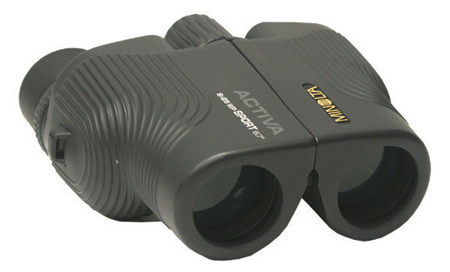Special Report:
What's New In Binoculars? Page 2
Binoculars that are exceptionally rugged tend to be heavy, but the new Zeiss Conquest series includes two models under 17 oz. The Conquest 8x30 (15.9 oz) and 10x30 (16.4 oz) are waterproof and fogproof, nitrogen filled, highly impact-resistant, and rubber-armored. These premium-grade binoculars feature T* anti-reflective coatings on all glass-to-air surfaces for great brightness and contrast as well as P* phase correction coatings on the roof prisms ($549 and $599).

Wide Angle Designs
While maximum magnification may be important for some uses, high-powered binoculars
have a very narrow field of view. Many outdoor and sports enthusiasts prefer
a model with a wider field of view, great for scanning a large area or for following
action subjects. Binoculars with a field of view of at least 400 ft at 1000
yards fall into the wide angle category and are particularly desirable. We're
seeing more models with a wide field of view, such as the new Olympus Trooper
DPS 7x35 and 8x40 rubber-clad models, with a 486 ft and 429 ft field of view,
respectively. Surprisingly affordable, the Troopers include amenities such as
enhanced porro prisms, aspherical lens elements to minimize distortion, mono-layer
coating plus UV ray protection ($49 and $69).
The new Swift Ultra Lite 8x32 ($199) features an extra wide 436 ft field of
view while Nikon's very affordable Action 7x35 and 8x40 models (with multi-coated,
high-resolution, aspherical lens systems) provide a field of view of over 420
ft and an apparent angle of view of 65Þ ($69 and $79). Nikon's new
Action Extreme ATB 7x35 and 8x40 roof-prism binoculars (with waterproof, fogproof,
all-metal chassis and multilayered coated lenses) also offer a wide field of
view, 420 ft ($129 and $179).

Maximum Light Transmission
Binoculars designed for low-light viewing generally include large objective
(front) lenses as well as a wide exit pupil. Intended for astronomy, the Meade
Travel View 9x63, a BaK-4 roof-prism model, for example, offers a 63mm objective
lens, an exit pupil of 7mm, and a very high Relative Brightness Rating of 49
(Twilight Factor of 23.8). Waterproof and fogproof, this model is heavy (2.75
lbs) but quite affordable ($129). Ideal for a broader range of applications,
the Canon 7x42 AWP is a sleek and slim model with a 6mm exit pupil and a Relative
Brightness Rating of 36, suitable for night and low-light viewing. These roof-prism
binoculars, with aspherical elements in the eyepiece, are nitrogen filled and
highly water-resistant, allowing for a short period of immersion (26.5 oz; $249).
The Swift Ultra Lite 9x63 ZWCF (armored) is also impressive with its huge 63mm
objective lens, multi-coated BaK-4 porro prism, and wide 7mm exit pupil. Those
features combine to produce a Relative Brightness Rating of 49 or a Twilight
Factor of 23.8 (2 lbs; $299). Many ultra-bright binoculars are large and heavy
but Steiner's powerful 10x50 and 12x50 Predators, with roof prisms, are
relatively compact and quite lightweight (under 30 oz) in spite of their 50mm
objective lenses. Featuring high-grade optical glass and phase-corrected BaK-4
prisms, the new water-resistant and fogproof Predators were designed to deliver
exceptional sharpness and clarity ($849 and $899).

Steiner's new Nighthunter 7x50, 10x50, 8x56, and 12x56 XP binoculars are
incredibly bright with a peak light transmission of 97 percent on most models,
useful for viewing before dawn and after dusk. According to the tech notes,
the German engineers achieved this impressive level with "HD" (High
Definition) broadband lens coating, an inner light absorbing baffle to nearly
eliminate internal stray light, and an improved porro-prism design ($599-$869).
Wide exit pupils and large objective lenses are useful in low light but other
optical strategies can be employed to maximize image brightness. Leica's
new nitrogen filled and waterproof Ultravid BR/BL series, for example, feature
the High Lux System (HLS), a coating that enhances the prism. It's applied
utilizing an advanced Physical Vapor Deposition process generated by an ion
beam and particle accelerator. Forty-three separate coatings are applied in
a thickness as little as 40 nanometers to transfer 99.9 percent of the light
for maximum brightness. Additionally, a new mechanical and optical design improves
contrast and total light transmission. The Twilight Factor ranges from 17.1
for the 7x42 model to an impressive 20 for the 10x50 model. The Ultravid BR/BL
series, in a magnesium alloy body, is expensive ($1425-$1650) but offers premium-grade
Leica optical and mechanical components as well as many useful features including
fast focusing.
- Log in or register to post comments

































